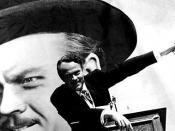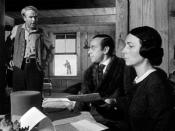Orson Welles' 1941 film, "Citizen Kane", is a powerful dramatic tale about the uses and abuses of wealth and power. It is a classic American tragedy about a man of great passion, vision, and greed. He attempts to push everything to the limit, but he ends up pushing too much, causing the eventual ruin of himself and all around him. Although Citizen Kane is known for having one of the greatest storylines of all time, it is the production aspect that makes Citizen Kane so memorable. The movie is a visual masterpiece, a horde of enlightening camera angles and magnificent images that had never been attempted before, and arguably, has never been equaled since. The movie's cinematographer, Greg Toland, had many new and innovative ideas that he had planned to institute in Citizen Kane. The most noted of these groundbreaking effects is his perfecting of a deep-focus technique that allowed him to photograph backgrounds with as much clarity as foregrounds.
An example of this is seen early in the film when Kane's parents are discussing his future in the foreground of the shot, while through the window Kane is seen playing outside in the snow. In addition to Toland's perfecting of the deep focus, he and Welles had interesting ideas about camera angles and other effects. They wanted to revolutionize the movie industry, and through their hard work they were able to accomplish their goal. In Orson Welles' pioneering 1941 film, Citizen Kane, he and Greg Toland incorporated their many innovative cinematographic ideas, which were displayed through the evident mastery of the camera and its ability to use deep focus, and interesting visual effects.
The term deep focus is defined as "a strategy of lighting, composition, and lens choice that allows everything in the frame to...


